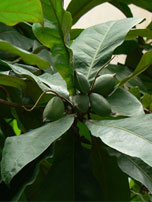SHAHEED KARTAR SINGH SARABHA AYURVEDIC MEDICAL COLLEGE & HOSPITAL
Affiliated to Guru Ravidas Ayurved University, Hoshiarpur Punjab
Affiliated to Guru Ravidas Ayurved University, Hoshiarpur Punjab

Botanical Name : Terminalia catappa L.
Family : Combretaceae (Rangoon creeper family)
Introduction :
Indian almond is a fast-growing deciduous or semi-evergreen tree, usually growing about 15 metres tall with specimens up to 40 metres recorded. The canopy has a pagoda-like habit when young, but this becomes less noticeable as the tree ages and the branches elongate and droop at the tips. The bole can be straight or twisted, it is generally set with short woody spines, can be 100 – 150cm in diameter and is often buttressed at the base with buttresses up to 3 metres high.
An important, multi-purpose tree, providing food, medicines and a host of other commodities. This is one of the most common trees of many tropical coasts. It is widely cultivated in the tropics, as a shade tree, for ornament and for its edible seeds. It is often planted in avenues as a shade-tree, for which it is suitable because of its very regular shape
Names in different Indian languages :
English : Indian Almond
Hindi : Jangli badam
Marathi : Jangli badam
Tamil : Nattuvadumai, Vadumai
Malayalam : Ketapag
Telugu : Tapasataruvu
Kannada : Kaadubaadaami, Naatibaadaami, Naadubaadaami, Tavasa
Oriya : Desiyobadamo
Gujarati : Badamalili
Sanskrit : Inguda, Ingudee, Taapasataru
Mizo : Thing-nihliap
Synonyms :
Terminalia intermedia Bertero ex Spreng.
Terminalia latifolia Blanco Non Sw.
Terminalia mauritiana Blanco
Terminalia moluccana Lamk.
Morphology :
The tree grows to 35 m (115 ft) tall, with an upright, symmetrical crown and horizontal branches. Terminalia catappa has corky, light fruit that are dispersed by water. The seed within the fruit is edible when fully ripe, tasting almost like almond. As the tree gets older, its crown becomes more flattened to form a spreading, vase shape. Its branches are distinctively arranged in tiers. The leaves are large, 15–25 cm (5.9–9.8 in) long and 10–14 cm (3.9–5.5 in) broad, ovoid, glossy dark green, and leathery. They are dry-season deciduous; before falling, they turn pinkish-reddish or yellow-brown, due to pigments such as violaxanthin, lutein, and zeaxanthin.
The trees are monoecious, with distinct male and female flowers on the same tree. Both are 1 cm (0.39 in) in diameter, white to greenish, inconspicuous with no petals; they are produced on axillary or terminal spikes. The fruit is a drupe 5–7 cm (2.0–2.8 in) long and 3–5.5 cm (1.2–2.2 in) broad, green at first, then yellow and finally red when ripe, containing a single seed. Pollen grains measure about 30 microns.
The species epithet is based on its Malay name Ketapang..
Distribution & Habitat :
A mid-canopy tree in areas just inland from ocean beaches, near river mouths, and on coastal plains. These areas are typically flat, but they may have dunes or rocky bluffs. Sandy or rocky beaches
Uses :
Various parts of the tree, such as the leaves and fruit, contain tannins and are astringent.
The leaves, crushed with Dacrydium elatum and rhizomes of Cyperus rotundus, are combined to treat dysentery.
The red leaves act as a vermifuge, while the sap of young leaves, cooked with oil from the kernel, is used to treat leprosy. The juice of the leaves is ingested for coughs. An infusion of the leaves is used to treat jaundice. The leaves are used to treat indigestion. The young leaves are used to cure headaches and colic.
Externally, the leaves may be rubbed on breasts to cure pain or, when heated, may be applied to numb parts of the body. They may be used as a dressing for swollen rheumatic joints. The leaves, applied to the head and sides, are refreshing and sudorific.
Leaves, bark and fruit are used to treat yaws.
The bark and root bark are useful for bilious fever, diarrhoea, thrush, and as a remedy for sores and abscesses. The fluid from the bark is used to treat diabetes and as a tonic. An infusion of the bark is used to treat stomach ache and also as an emetic for infants.
Externally, the bark is used to treat sores, pimples and fungal skin diseases.
The kernel of the fruit mixed with beeswax stops putrid exudation and bloody faeces. It is recommended as a mild laxative and a galactagogue for women, but too frequent use causes diarrhoea.
